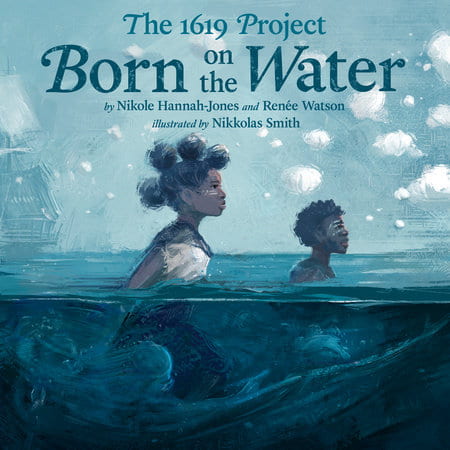Authors: Nikole Hannah-Jones and Renèe Watson
Illustrator: Nikkolas Smith
Reviewed by: Erin Healy
This story is powerful. A part of the 1619 Project, this book tells the origin story of Black Americans from Ndongo before they were enslaved. We see people who had full, rich lives. Who had knowledge and culture and joy. Until one day it was all brutally taken away. The story repeats: “Ours is no immigration story.”
The book begins narrated by a young Black girl who has a school assignment to draw a flag that represents her ancestral lands. She feels ashamed because she doesn’t know where her family’s story begins. That night her grandma tells her the story. She speaks of Ndongo and speaking Kimbundu and how they were good with their hands. She speaks of how the people were also good with math and science and had a robust society. How they had dance and music and each other. She tells of the day the White people came and took them upon the White Lion and sold and enslaved them. She tells of how they persisted and resisted and created a new home and a new people: a people powerful; skilled and brave. Those are her people, and that is her story. A story that continues today through the strength of Black people and the continuation to resist and persist, by way of the Black Lives Matter Movement, and other collective activism.
Written in verse, this story’s words are as beautiful, powerful, and haunting as the illustrations. It is part of history students are curious about and deserve to know. Until this book, I have never seen Black history before enslavement taught in schools or any books on the topic. This is just as much a part of American history as learning about Europe before the colonists or Native Americans before the Genocide of their people. We are doing a disservice to Black children to keep this history from them, and a disservice to all children to not remember slavery for what it was: a complete, brutal dehumanization of very human people, and how they have fought to free themselves ever since they forcibly arrived. This book does just that. I think it could be used age appropriately in any grade, done strategically by the teacher. The poetic style means that there are details left unsaid, some of which are alluded to in the images, but others that would take more unpacking and information. Younger grades could focus on people’s lives before being enslaved and just introduce the topic of slavery, while there is room to build on the atrocities of the history for older grades. This book could be read every year with students and each year they could delve deeper, gain something new, reflect on the history and how it relates to the present in a new way. I believe that Born on Water should be a staple in every elementary classroom in the country.
Here is a link to The 1619 Project which has an abundance of articles and resources.
Here is a link to Pulitzer center lesson plans and resources for educators in conjunction with The 1619 Project.
